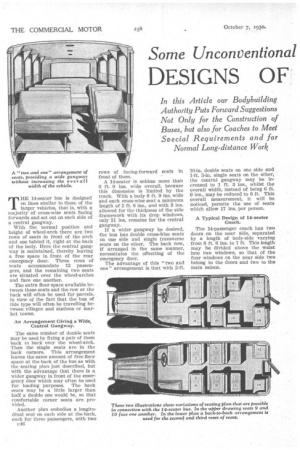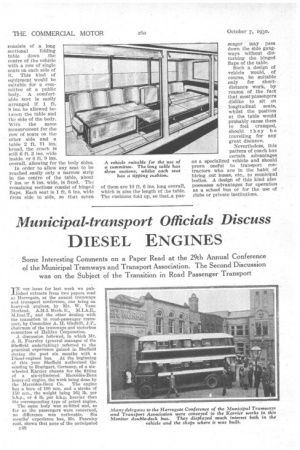Some Unconventional
Page 68

Page 69

Page 70

If you've noticed an error in this article please click here to report it so we can fix it.
DESIGNS OF 1 4 SEATER
In this Article our Bodybuilding Authority Puts Forward Suggestions Not Only for the Construction of Buses, but also for Coaches to Meet SPecial Requirements and for Normal Long-distance Work
THE 14-seater bus is designed on lines similar to those of the larger vehicles, that is, with a majority of cross-wise seats facing forwards and set out on each side of a central gangway.
With the normal position and height of wheel-arch there are :two rows of seats in front of the arch and one behind it, right at the back of the body. Here the central gangway is maintained, thereby leaving a free space in front of the rear emergency door. Three rows of seats accommodate 12 passengers, and the remaining two seats are situated over the wheel-arches and face one another.
The extra floor space available be-j tween these seats and the row at the back will often be used for parcels, in view of the fact that the bus of this type will often be travelling between villages and stations or market towns.
An Arrangement Giving a Wide. Central Gangway.
The same number of double seats may be used by fixing a pair of them back to back over the wheel-arch. Then the single seats are in the back earners. This arrangement leaves the same amount of free floor space at the back of the bus as with the seating plan just described, but with the advantage that there is a wider gangway in front of the emergency door which may often be used for loading purposes. The back seats may be a little larger than half a double one would be, so that comfortable corner seats are provided.
Another plan embodies a longitudinal seat on each side at the back, each for three passengers, with two c46 rows of facing-forward seats in front of them.
A 14-seater is seldom more than 6 ft. 9 ins, wide overall, because this dimension is limited by the track. With a body 6 ft. 9 ins, wide and each cross-wise seat a minimum length of 2 ft. 8 ins., and with 3 ins, allowed for the thickness of the side framework with its drop windows, only 11 ins, remains for the central gangway,
if a wider gangway be desired, the bus has double cross-wise seats on one side and single transverse seats on the other. The back row, if arranged in the same manner, necessitates the offsetting of the emergency door.
The advantage of this "two and one" arrangement is that with 2-ft. 10-in, double seats on one side and 1-ft. 5-in, single seats on the other, the central gangway may be increased to 1 ft. 3 ins., whilst the overall width, instead of being 6 ft. 9 ins., may be reduced to 6 ft. This overall measurement, it will be noticed, permits the use of seats which allow 17 ins, per person.
A Typical Design of 14-seater
The 14-passenger coach has two doors on the near side, separated by a length of body-side varying from 6 ft. 6 ins. to 7 ft. This length may be divided above the waist into two windows, so that of the four windows on the near side two belong to the doors and two to the main saloon.
The up-to-date miniature coach has all the refinements of that which has twice the seating capacity. As the body is narrower a sliding roof Is more easily fitted. The windows over the wheel-arches will not, as a rule, drop for their full depths, unless they be divided horizontally, but, in any case, they should be made adjustable.
As with the first seating plan described for the service bus, there are two rows of seats facing forwards and single wheel-arch seats. The chief problem with the 14-seater coach is how comfortably to accommodate the remaining four passengers.
How to Secure a Convenient Cross-gangway.
If the coach be 6 ft. 3 ins, wide inside, the back seat is long enough for four passengers, but the one sitting in the near-side corner has his or her legs and feet right in the doorway. If the back door be seldom used during the journey and a suitable fibor flap is provided to cover the step well, this may not be considered a great disadvantage.
If, however, a better cross gangway be desired, or the licensing authorities demand it, the back seat is sometimes a, triple one built against the off side and the extra passenger is accommodated beside the driver, preferably on a folding seat.
A small bus or coach may also be used for special purposes, such as the conveyance of a sports team. Cine of the seating plans already dealt with includes three rows of double seats, two of which are back to back.
It is suggested that the sociability of this seating plan could be ,increased by turning around the front row of seats. Then there would be four rows of seats facing each other in pairs. Between each pair of seats folding tables would be mounted. The back seats would, normally, be only single ones, but If extra accommodation were required flap seats could make up the deficiency, so that there were four persons at each table. Easily de
tachable seats would also Be an advantage, because they. could then be arranged as desired.
A. Central Longitudinal Table in a Coach.
Another method of arranging seats and tables in a small coach consists of a long sectional . folding table down the centre of the vehicle with a row of single seats on each side of it. This kind of equipment would be suitable for a committee of a public body. A comfortable seat is easily arranged if 1 ft. 8 ina, be allowed between the table and the side of the body. With the same measurement for the row of seats on the other side and a table 2 ft. 11 ins: broad, the coach is still 6 ft. 3 ins. wide inside. or 6 ft. 9 ins.
overall, allowing for the body sides.
In order to allow any seat to be reached easily only a narrow strip in the centre of the table, about 7 ins. or 8 ins, wide, is fixed. The remaining sections consist of hinged flaps. Each seat is 1 ft. 6 ins, wide from side to side, so that seven of them are 10 ft. 6 ins, long overall, which is also the length of the table. The cushions fold up, so that,..a pas senger may pass down the side gangways without disturbing the hinged flaps of the table.
Such a design of vehicle would, of course, be suitable only for shortdistance work, by reason of the fact that most passengers dislike to sit on longitudinal seats, whilst the position at the table would probably cause them to feel cramped, should they be travelling for any great distance.
Nevertheless, this pattern of coach has certain advantages as a specialized vehicle and should prove useful to transport contractors who are in the habit of hiring out buses, etc., to municipal bodies. A design of this kind also possesses advantages for operation as a school bus or for the use of clubs or private institutions.












































































































